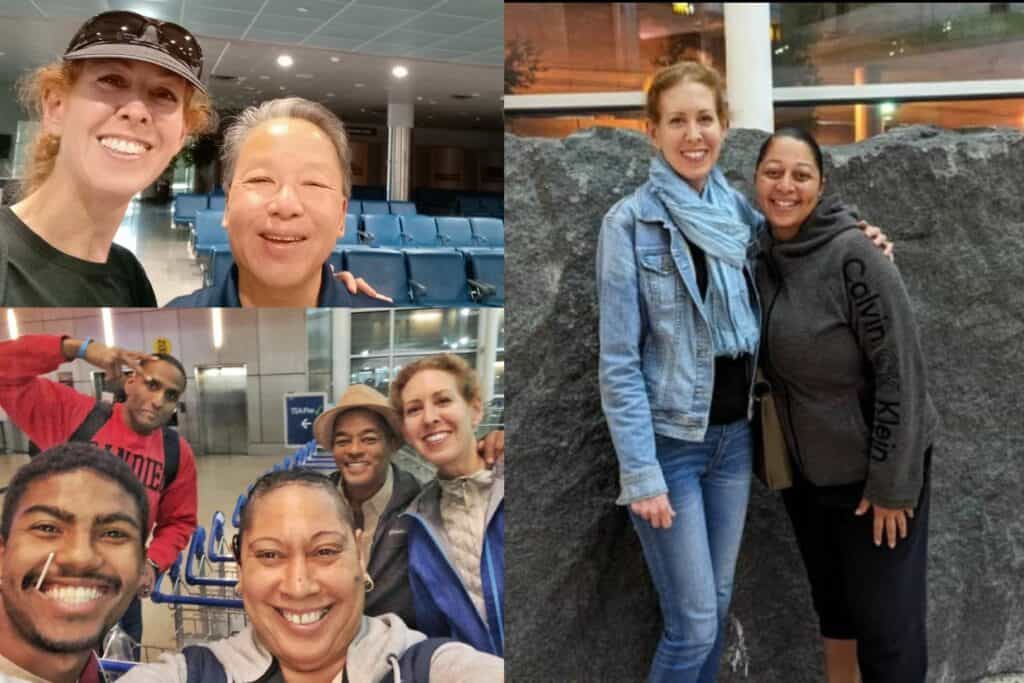
Flying space-available (Space-A) is a great privilege that we have used extensively over our past 9+ years of travel around the world. The savings, the adventure, the opportunity to ride military transports, and many times, the ease of taking military operational flights vs civilian carriers have been amazing!
But, if you’ve been a Poppin’ Smoke reader for a while, you probably know that we caution against flying Space-A during the summer months, winter holidays, and (to a lesser extent) spring break, especially for retirees and others in lower-priority categories.
In 2023, we took a calculated risk and disregarded our own advice, for reasons I will explain below.
Bottom line: flying Space-A during the summer can be VERY challenging. No matter how carefully you’ve followed flight schedules and seat releases, and no matter how promising a flight seems, have those contingency funds ready to fly commercial instead!
Here’s our trip report from our recent Space-A adventure to Japan.
Contents (click to expand)
Why Summer is a Hard Time to Fly Space-A and Why We Did It Anyway
First and foremost, why is it so difficult to get a seat during the summer?
In short, it’s because you face more competition for fewer overall Space-A seats. More space-required passengers occupy seats on the Patriot Express missions (aka “rotators”) during the summer. Also, there are more passengers flying Space-A, which impacts competition for open seats across all missions.
Summer is the main military PCS season. Starting as early as mid-May and lasting into mid-September, Patriot Express flights are full of active duty members and families traveling to and from their OCONUS duty stations. While these missions often release at least a few Space-A seats during the summer months, it’s generally a lot fewer than other times of year.
| Related Reading: How to Fly Space-A on the Patriot Express
Also, as soon as schools are out of session, many active duty families travel during summer vacation. As leisure travelers, they are in Category (Cat) 2 if using Environmental Morale Leave (EML) or Cat 3 if using Ordinary Leave.
With those factors in play, it’s much harder for would-be passengers in lower-priority (higher numbered) categories to get seats (military retirees are Cat 6).
So, why did we try it?
Two reasons:
- We had time and flexibility.
- Even if we planned to fly commercial back to the States, we would not have purchased tickets in advance.
I’ll explain further.
We originated our Space-A travel in the Seattle area. It was only mid-May, schools were still in session, and PCS season was just starting. So, we were confident that we could hop to Japan one way or another.
We also knew that after arriving in Japan, we wanted the flexibility to decide how long to stay. We lived in Japan for 2.5 years between 2016 and 2019 and had been unable to visit since we left, so we had many friends and family members to see.
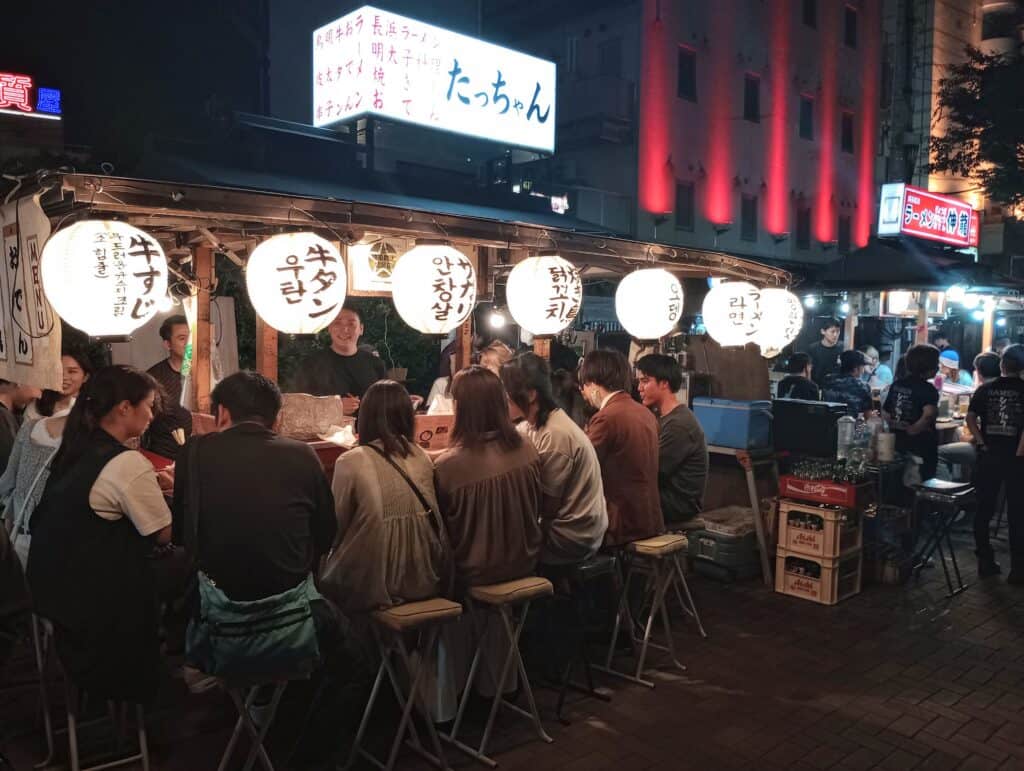
Also, while living in Japan, we flew commercial to the States many times, and it was our experience that the fare difference between tickets purchased far in advance and those purchased on a few days’ notice wasn’t drastic.
So, if Space-A worked out, great! If not, we were planning to purchase commercial tickets somewhat last minute anyway.
With that in mind, here’s how the adventure unfolded.
Seattle Airport, May 2023
We live in Rota, Spain, but I was already in the States for my dad’s 80th birthday. My husband took a Space-A flight to Norfolk, VA to visit an old friend, then flew commercial to join me in Chicago for the celebrations. Afterwards, we flew commercial to Seattle, which is where this Space-A adventure to Asia started.
We had been watching seat releases for the PEs from the Seattle AMC terminal for several weeks prior to travel. Although it was still early in PCS season, flights via Yokota AB (near Tokyo) were pretty full, often with single digit seat releases. But flights to Kadena AB on Okinawa and to Misawa AB/Osan AB (northern Japan and South Korea, respectively) had a lot of open seats.
| Related Reading: Where to Find Military Space-A Flight Schedules
Attempt #1: PE to Yokota AB, MCAS Iwakuni, and Kadena AB
The first flight for which we competed was a long shot based on the tentative seat count, but we showed up anyway. Roll Call was in the wee hours of the morning on Thursday, 11 May.
We arrived several hours before Roll Call and waited in the very long line to mark present. Remember that you must mark yourself present for a Space-A flight before Roll Call starts. If you don’t arrive far enough in advance and the agent doesn’t have time to process you, you’ve missed your opportunity to compete for the flight.
They released a few dozen seats, but not even close to the number of Space-A passengers competing. There were many folks traveling on EML (Cat 2). They all got seats, as did some of the Cat 3s.
| Related Reading: What Active Duty Travelers Should Know About Flying Space-A
Sometimes there are two Roll Calls for a PE, and normally, we would wait in the terminal to see if they released more seats. But the agent made it clear that no Space-A passengers lower than Cat 3 would make the flight.
We returned to our hotel, where we had not checked out of our room (knowing there was a good chance we wouldn’t make the flight). We went back to sleep and asked for late check out the next morning so that we had a place to hang out as long as possible. Then, we got ready to repeat the whole process again.
Attempt #2 – PE to Guam/Kadena AB
Based on recent seat releases, our chances for the PE to Guam/Kadena seemed much more promising, so we checked out of our hotel on Thursday and went back to the airport.
Again, we stood in line with many of the same travelers we met the night before. This time they released more seats, and some of the competition had cleared out the previous night. As far as I know, all Space-A passengers competing got seats.
After checking our bags, paying the $21 per-person tax (the tax is only for Space-A passengers on the PE), and receiving our boarding passes, we still had a few hours until the flight. We made our way to the gate and snoozed until it was time to board.
A couple important things to note about Seattle airport when hopping a PE:
- Retirees can access the USO on a space-available basis only. The day of a PE, the USO is often full of active duty travelers and their families, so retirees may not be allowed enter. Visit the SeaTac USO web page for more information and hours.
- After you receive your boarding pass and clear security, you must take the airport tram to get to the gate. The tram stops running late at night and resumes service around 4 a.m., so you may need to wait in the main terminal.
For both of these reasons, a sleeping pad comes in handy, because you can stretch out on the floor of the airport.
Our flight departed around 0600 on Friday, and the first stop was for refueling at Ted Stevens Airport in Anchorage, Alaska. Having never been to Alaska, it was pretty cool to see the mountains surrounding the airport!
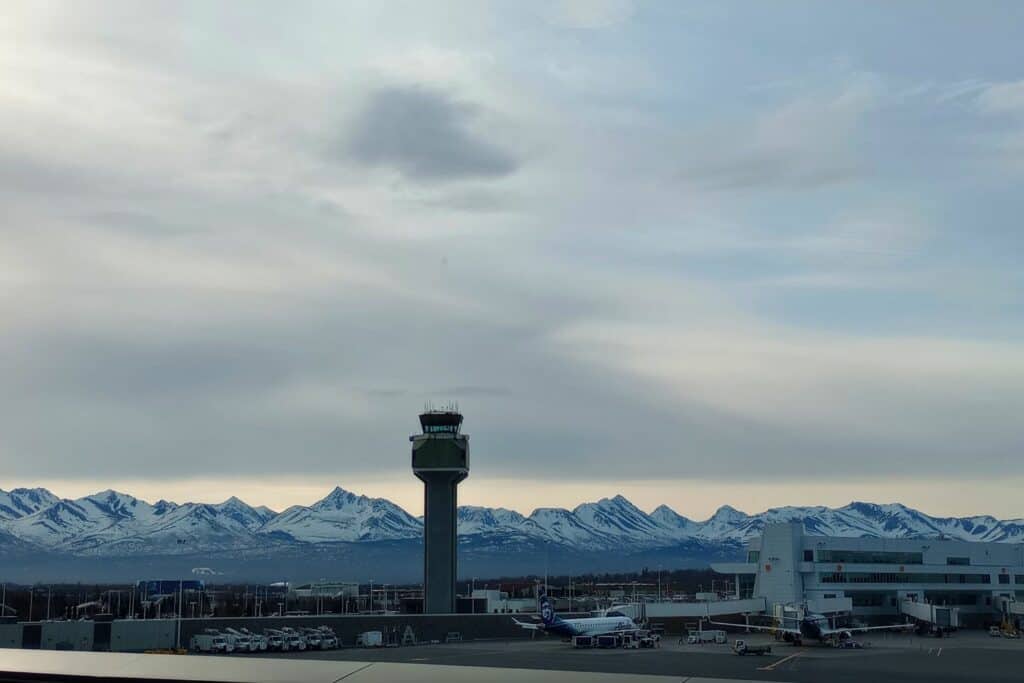
After a short layover, we reboarded the plane and flew to Anderson AFB in Guam. All passengers got off, and we used that opportunity to secure lodging at Kadena AB.
A fellow Space-A passenger contacted the Shogunn Inn, the Air Force lodging facility, and the lodge was full. Fortunately there is also a Navy Gateway Inns & Suites (NGIS) at Kadena.
Our cell phone service did not work well in Guam, and NGIS wasn’t answering their DSN line, so I used the terminal’s WiFi to call the toll-free DoD Lodging number via Skype.
We seldom go through DoD lodging to make Space-A reservations (here are the tricks we usually use), but this time it was a last resort, and it worked!
I passed my phone to a couple other retirees to make their own reservations, and we all got rooms just before it was time to re-board.
Because we were manifested all the way to Kadena, we did not need to re-compete for Space-A seats from Guam.
After the third leg of our journey, we arrived at Kadena around 1900 local time on Saturday.
Members of the passenger terminal staff drove retirees and other non-SOFA passengers to the Japanese immigration office to get our passports stamped, then they dropped us off at our respective destinations on base. (This article explains more about the immigration process at Kadena).
We arrived at NGIS around 2200. Keep this timeline in mind if you plan to book follow-on travel after landing at Kadena. It takes a while to complete all of the immigration-related procedures, especially if you arrive on a flight with many passengers who need to go to immigration.
NGIS was $92 (no tax) for a standard queen room.
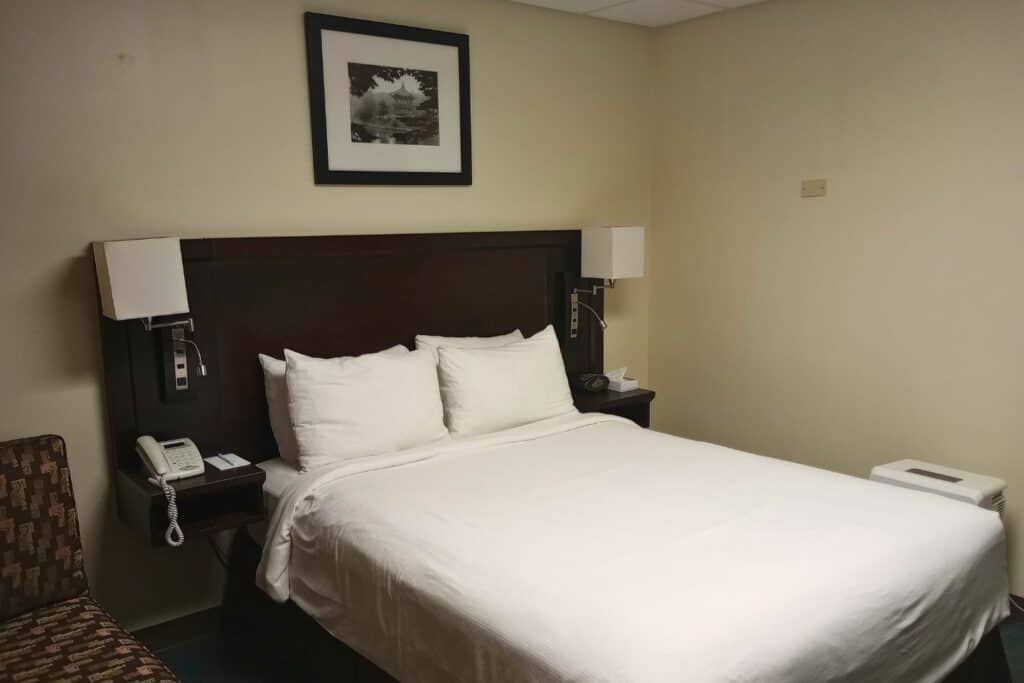
Okinawa to Tokyo
While we love Okinawa, the people and places we wanted to visit during this trip were on mainland Japan, so we needed to go to Tokyo. Kadena had no Space-A flights to Yokota on the schedule for the next couple days.
So, after landing at Kadena, we booked commercial flights to Tokyo for the next day. They were about $140 per person and included a checked bag (the airline did not have a fare option for carry-on bags weighing more than about 15 lbs).
The morning after we landed, we took a cab to the civilian airport on Okinawa (around $55) and flew to Tokyo Narita.
Tokyo has two main airports: Narita and Haneda. Haneda is much closer to the city center, but sometimes flights are cheaper into Narita.
After landing at Narita, we bought data-only sim cards, meaning we could not make phone calls except using WiFi-based apps. They were valid for 30 days and cost about $43 each.
Narita has a convenient train station connected to the terminal, and I highly recommend stopping at the information desk to get your bearings. The English-speaking staff explained how to buy a rechargeable fare card from the machine (we were a little rusty after 4 years outside Japan) and confirmed the best route to our destination in central Tokyo.
The train took about 90 minutes and cost less than $20 per person.
More “Military Style” Travel: Tokyo and Surrounding Areas
On previous trips to Tokyo, we stayed at the New Sanno, an upscale military hotel. I highly recommend staying there at least once. Read this article for our review and advice on getting a reservation.
This time, we wanted to try the other Tokyo military lodging: Hardy Barracks, aka Camp Zama’s Tokyo Recreational Lodging. It’s an Army MWR lodging facility in the Roppongi area on a small U.S. military installation called Akasaka Press Center. The only other building on the installation is the headquarters of Stars & Stripes Asia.
That building also has a fitness center and small Exchange store. (Note: retirees can shop at the Exchange and commissary, plus use MWR facilities on bases in Japan.)
At only $65/night for a spacious suite, Hardy Barracks was a great deal!
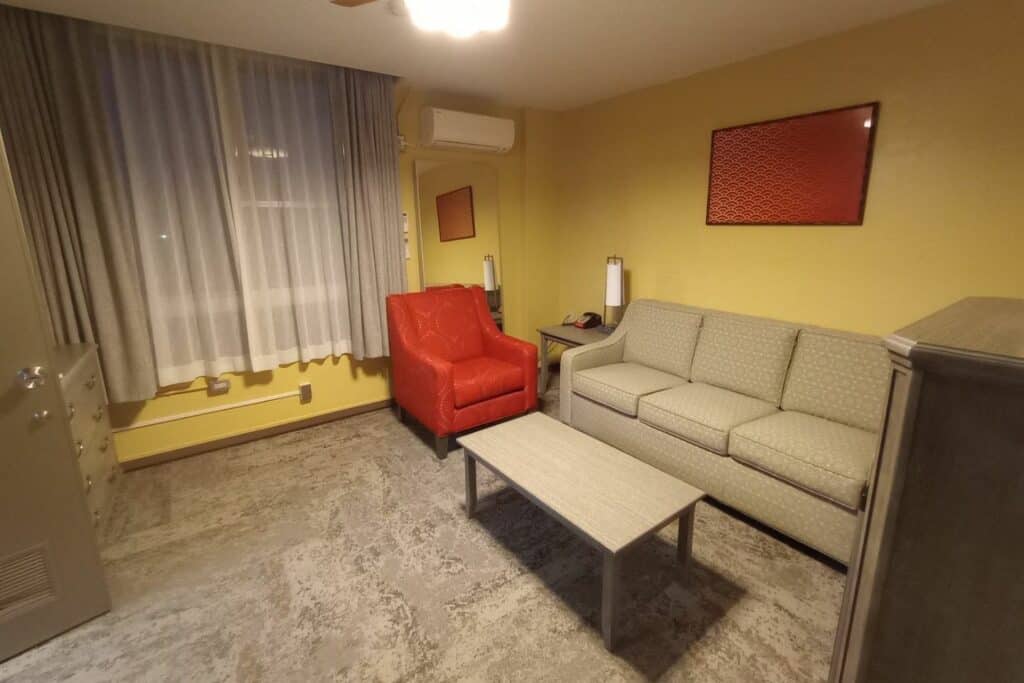
We mainly used our time in Tokyo to relax, catch up on sleep, see a couple friends, and seek out some of the food we had missed over the past 4 years.
From Tokyo, we again took the train to Yokosuka to visit our niece, who is a teacher at the school on base. We used Google Maps to determine the route, which took less than 90 minutes (including multiple transfers) and cost less than $10.
Pro tip: If you plan to use the train system in Japan, make sure you can carry your suitcase up and down a flight of stairs. This is important for short connections when you don’t have time to walk out of your way to find the elevator/escalator. Start with a very lightweight suitcase (mine weighs only 5.4 lbs) and pack light!
Yokosuka has a Navy Lodge and an NGIS. The NGIS is conveniently located right inside the front gate, so we preferred to stay there. They did not have a room when we called the night before arrival, but we followed their advice to try again after 18:00 the next day, and sure enough, they had a room. Our small suite with kitchen was $110.
Next stop, NAF Atsugi! Our niece wanted Mr. Poppin’ Smoke to play in a golf tournament with her friend, and it was an early start, so we went to Atsugi the night before. Once again, we took the train, combined with a taxi.
The suite with kitchen at NGIS was $87, and it was one of the nicest settings for military lodging I’ve seen.
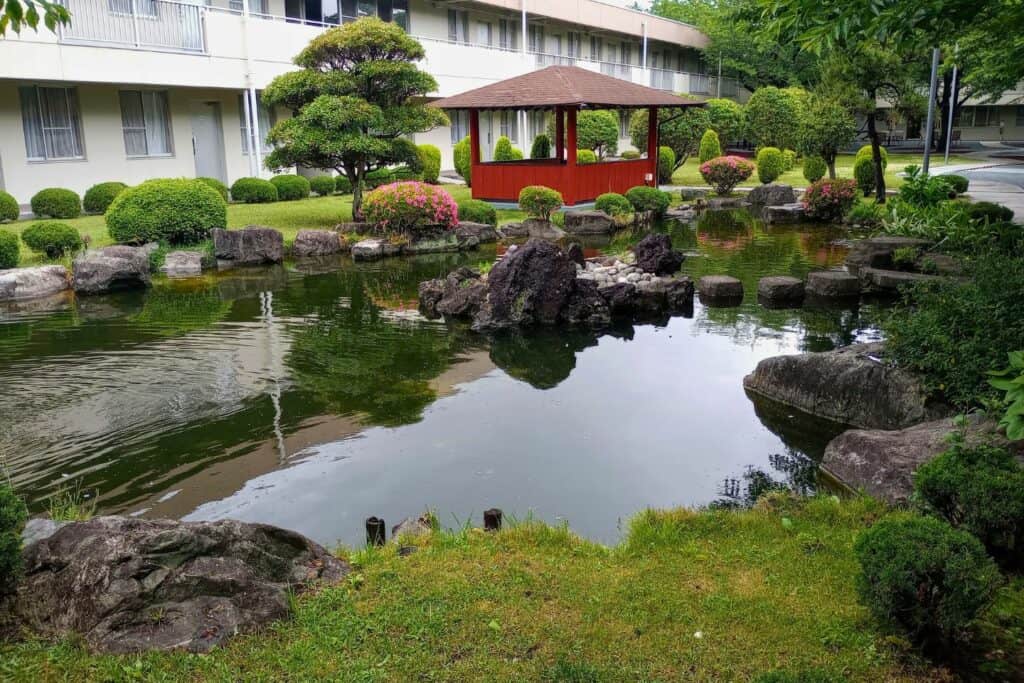
That was the last “military style” portion of our trip for a while. For the next several weeks, we stayed in hotels and furnished apartments while visiting friend and family in Nagoya, Kagoshima, and finally, Fukuoka, our former home between 2016 and 2019.
| Related Reading: How to Use Airbnb in Japan
Note that we did not purchase Japan Rail passes during this trip. In retrospect, they probably would have saved us money, but we were making all of our plans on the fly, and we wanted as much flexibility as possible.
June 2023: Deciding Where to Try Our Luck for Space-A Back to CONUS
The last couple weeks of our trip to Japan were in Fukuoka, which is not near any U.S. military bases with Space-A flights. We had to decide where to fly commercial to start our journey.
To make that decision, we considered our chances of getting seats as well as the cost of spending time at each base.
Option #1: Yokota AB
Yokota AB generally has a lot of flights, but competition is often stiff. PCS season was in full swing, and the recent PEs to Seattle showed few or no seats.
Also, rooms at the Kanto Lodge, the only base lodging facility, started at $109/night. You can get around Yokota without a car (we did it for 10 days in 2019), but some base facilities are a long walk if it’s raining or very hot, both of which are likely scenarios mid-summer.
Option #2: Kadena AB
Kadena AB looked more promising, with lots of open seats on the PE that goes directly to Seattle (via Anchorage). But Kadena is large and very spread out, so it’s hard to get around without a rental car or taxis. Also, there is no shuttle to the civilian airport.
The costs of ground transportation and lodging can make Kadena an expensive place to get stuck.
Option #3: Osan AB
Our third option was Osan AB in South Korea. Recent PEs had plenty of empty seats, and since we would board at the first departure point heading back to CONUS and manifest to Seattle, we wouldn’t need to compete with other Space-A passengers at stops along the way. Osan also had other Space-A activity on cargo flights.
Other factors that made Osan the (seemingly) better choice over Kadena were the cheap lodging ($63/night), the fact that everything on the base is within easy walking distance, and the convenient base shuttle from Seoul Incheon airport.
| Related Reading: What You Need to Know About Flying Space-A via Osan AB
We decided to try Osan, and we booked our tickets to Seoul the day before travel ($98 each).
First Weekend at Osan AB
We arrived at Osan on Thursday, 15 June. It was well in advance of the next PE on 20 June, but we wanted a few days to relax and explore the base, because we had not spent much time there.
As is often the case, base lodging was full when we first called to make reservations, but we eventually secured a room using our usual strategies.
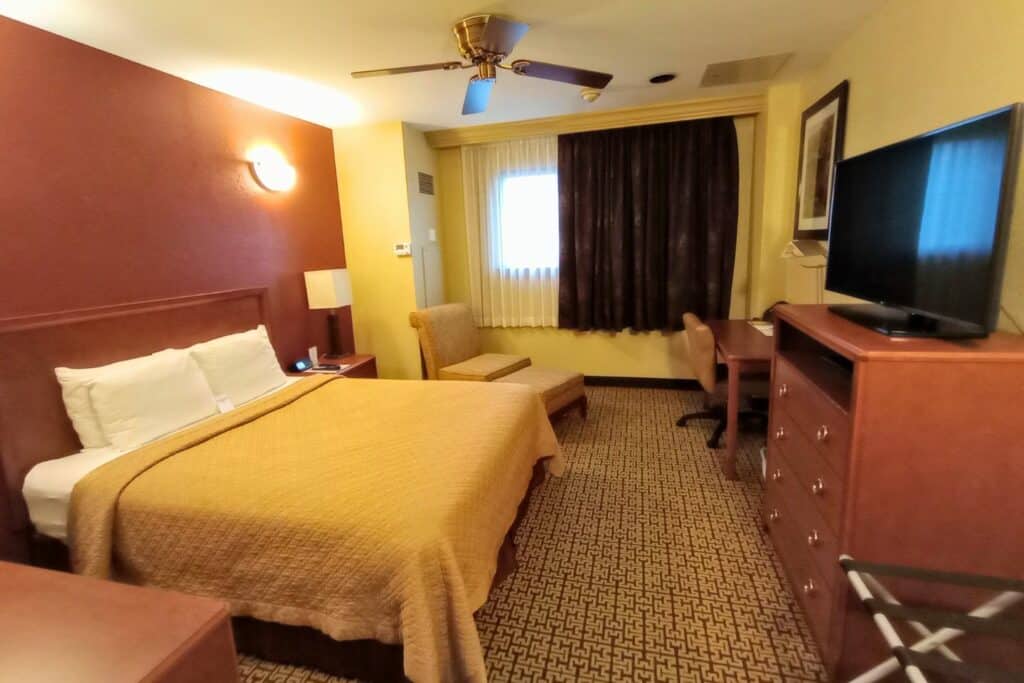
In our first few days there were a couple flights on the schedule.
One was a mission that, at various points, showed stops in Australia, Alaska, California, Texas, and South Carolina. Ultimately, that mission did not take Space-A passengers, but we would not have competed for it anyway.
After more than a month of travel and having decided it was time to go home, we weren’t up for a detour to Australia. Also, with a mission like that, you never know now many days the aircraft will stay in each location.
Another mission on the schedule was to JB Pearl Harbor-Hickam and Travis AFB. It was a C-5 coming from Okinawa, and Roll Call was pushed back 24 hours several days in a row.
While we usually follow our rule to “take the first thing smokin'”, we also decided not to compete for that flight. Hawaii is a very expensive place to get stuck, so we actively avoid that scenario when we don’t otherwise want to spend time in Hawaii.
Coming from Asia, we were fairly certain that flight would have at least one night of crew rest in Hawaii. So, best case scenario, we would get base lodging starting around $150/night (more than twice what we were paying at Osan). If not, staying in a hotel off base in the middle of summer would be very expensive.
Also, knowing that the aircraft had already had numerous maintenance issues, it seemed likely that we could end up spending multiple nights in Hawaii. So, we decided to stick with our inexpensive, comfortable situation at Osan.
Two Promising Flight Opportunities
On Monday, 19 June, the night before the Patriot Express to Misawa AB and Seattle, the schedule showed around 30 tentative seats. There was also a mission to JB Elmendorf in Alaska with a Roll Call a couple hours after the PE Roll Call. When we inquired on Monday, the passenger terminal staff told us it was a C-17, but seats were still TBD.
With Plans A and B, we felt optimistic as we made our way to the terminal the next morning. We arrived more than 2 hours before Roll Call to mark ourselves present for the PE, because we had been unable to do so the day before (the terminal was closed for a holiday), and we did not know if there would be a long line.
The terminal was packed with service members and families PCSing. As it turned out, there were also dozens of Space-A travelers.
With schools out for the summer, many families with kids were traveling back to the States. The passenger terminal rep told us that he had never seen so many folks show up for Space-A, and as I mentioned above, this is not the picture we got from Osan’s recent Roll Call reports.
That rep also told us that the Alaska flight was not releasing any Space-A seats.
We waited in the terminal, knowing we wouldn’t make the PE on the first round (the lowest category passenger who got seats was Cat 3). But we held out hope that after the other unsuccessful Space-A passengers went home, passenger terminal staff would release a couple more seats and we would get lucky. It happens sometimes, but not that day!
We also hoped that the crew of the C-17 would see two Space-A passengers, packed and ready to go, and decide they could squeeze us in. We’ve gotten seats this way in the past, but again, it was not our lucky day.
So, we walked back to the lodge (I called from the terminal to reserve a room when I realized that our chances of getting out were slim) and checked into a new room.
Our consolation prize was discovering that the Korean employee cafeteria on base has great food and is extremely cheap!
Plan C (for Me)
At that point, there were no promising flights on the schedule for the next 72 hours. The next PE to Seattle was two days later, but it was via Yokota AB. Between the large number of Space-A passengers at Osan and the small number of seats released for recent Yokota/Seattle PEs, we knew that chances for getting on that flight were slim.
From a strict cost perspective, we could have stayed at Osan for weeks, and it still would have been less expensive than two commercial airfares back to the States. But a family issue had come up for me, and I needed to get back to Chicago by 25 June, so I was running out of time.
We agreed that I would fly commercial from Seoul, so I bought a ticket to Chicago. The ticket, purchased two days before travel, was $1,325 (I always use Skyscanner to search for flights).
We had been traveling for more than a month, and Mr. Poppin’ Smoke had some administrative things to take care of in Washington State, but he had more flexibility. So, we decided that he would give it a few more days.
Plan D
One of our rules of Space-A travel is that we always try for a flight, no matter how unlikely it seems (especially if we are already staying on base). So, early on Thursday, 22 June, Mr. Poppin’ Smoke packed his bags and went to the terminal to compete for one of the few seats released for the PE to Yokota AB and Seattle.
Not surprisingly, he was back in the room a short while later, and we had lunch at Checkertails, the diner on base, before I took the shuttle to Seoul Incheon airport (details about both are in this article).
Plans E, F . . .
Mr. Poppin’ Smoke stayed at Osan until 26 June. In that time, a few flights came on the schedule and either dropped off or did not take Space-A passengers.
Seats for the next PE were still TBD, and based on his last two experiences, it seemed unlikely he would make the cut. So, with nothing to indicate he had a good chance of getting out within the next few days, he decided to cut bait and fly commercial. He bought a same-day ticket to Seattle for about $1,300, which was a few hundred dollars cheaper than any of the flights he saw in the upcoming days.
(He wanted to make sure you all know, the golf course and rental clubs at Osan are top notch. He got in four rounds of golf while waiting, so he made good use of his time!)
The Costs of Attempting Space-A
By coming to Osan, here is what we spent on lodging and transportation (as noted in this article, food on base is cheap):
Flights from Fukuoka to Seoul: $200
Airport shuttles to/from Seoul Incheon: $80 ($20 x 4)
Lodging at Osan: $693
Flights to the U.S.: $2,625
As I explained in the beginning, we never considered buying commercial airfare back to the States until we knew when we were ready to leave Japan. So, we compare the costs of our Space-A attempt to how much we would have spent by flying from Fukuoka to the States with a week or so of advance notice.
From what I saw in my research, we would not have saved much, if anything, on airfares themselves by purchasing a few extra days before travel. Mainly, we would have avoided the other costs associated with going to Osan, but as noted above, that was partially a scouting mission to check out Osan.
All in all, we consider our adventure a success, because we . . .
- Got a free flight to Japan and met great people along the way.
- Saw firsthand that active duty members were wasting time and money trying to fly Space-A without knowing how it works, prompting this article to help avoid those situations in the future.
- Tested three military lodging facilities in the Tokyo area.
- Had a fantastic time in Japan visiting family and friends.
- Met Phylesia Mickens, the Air Force retiree who works at Osan AB and is featured in this Expat Military Retiree Profile.
- Learned our way around Osan, ate the best pancakes we’ve had in recent memory, and tested out the golf course.
Last but certainly not least, we gathered a lot of new intel and experiences to share with you, our readers!
What Should You Take from Our Summer Space-A Experience?
For many of you, our experience reinforces what you already knew: flying Space-A during the summer is tough. For those who are new to Space-A, now you know why you should think twice before using it during PCS season and other busy times of year.
Whether you should attempt Space-A during the summer depends on your situation.
If you have time, flexibility, a spirit of adventure, and enough money to cover the expenses in the event that Space-A doesn’t work out, give it a shot!
But if you’re planning a major family vacation, I don’t recommend relying on Space-A.
Our attempt to fly Space-A out of Osan also raises an important question: How long should you keep trying for a hop before you throw in the towel and fly commercial?
As you can see from our experience, it’s not always easy to decide. Flying Space-A has the potential to save you thousands of dollars on airfare (especially with multiple travelers flying to/from OCONUS locations). If you have time to wait and lodging is cheap like at Osan, it‘s worth sticking it out for a while.
But you could also spend a lot of money on lodging, food, and local transportation and still end up flying commercial.
And you never know when, if you had just given it one more day, you would have gotten seats.
Remember that PE with seats still TBD when Mr. Poppin’ Smoke decided to fly commercial? According to Osan’s Roll Call Report, they released more than 80 seats. We don’t know for sure whether he would have gotten one of them, but it seems likely.
That’s how it goes with Space-A! You win some, you lose some. On the whole, we’ve won much more than we’ve lost, and we look forward to our next Space-A adventure!
Hope to see you in the future giving it a try!
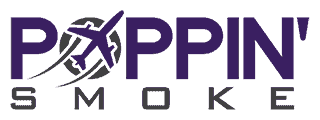
Thank you so much for all your information and space A tips. We are planning a space A trip to Okinawa in August, (hubby isn’t retired yet) so hoping for a good flight experience. We have traveled space A many times in the past. Again, thank you!
Hi Becky – Good luck and have a fun adventure! Thanks for reading!